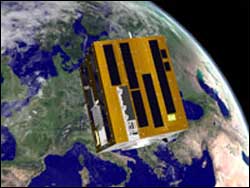This area deals with the fundamental laws and building blocks of nature and how they interact, the properties and the behavior of matter, and research into space and time and their structures.
innovations-report provides in-depth reports and articles on subjects such as astrophysics, laser technologies, nuclear, quantum, particle and solid-state physics, nanotechnologies, planetary research and findings (Mars, Venus) and developments related to the Hubble Telescope.

In the last few years, semiconductor circuit features have shrunk to sub-100 nanometer (nm) dimensions, while the size of the thin silicon wafers that these circuits are constructed on has grown from 200 millimeters (mm) to 300 mm (about 12 inches). The payoff is a higher yield of finished devices from fewer wafers.
The tough part, however, is to make wafers substantially larger while simultaneously meeting higher quality control specifications. The optics and materials for “print

Extreme ultraviolet lithography (EUVL) may be the next-generation patterning technique used to produce smaller and faster microchips with feature sizes of 32 nanometers and below. However, durable projection optics must be developed before this laboratory technique can become commercially viable. As part of its long-standing effort to develop EUVL metrology and calibration services (summarized in a recent paper*), the National Institute of Standards and Technology (NIST) is creating a measurement s

For makers of computers, disk drives and other sophisticated technologies, a guiding principle is the smoother the surfaces of chips and other components, the better these devices and the products, themselves, will function.
So, some manufacturers might be surprised to learn that a fast and increasingly popular method for measuring surface texture can yield misleading results. As reported at recent conferences and in an upcoming issue of Applied Optics,* a team of National Instit

An international team of scientists has uncovered a rare type of neutron star so elusive that it took three satellites to identify it.
The findings, made with ESA’s Integral satellite and two NASA satellites, reveals new insights about star birth and death in our Galaxy. We report this discovery, highlighting the complementary nature of European and US spacecraft, on the day in which ESA’s Integral celebrates 1000 days in orbit.
The neutron star, called IGR J16283-48

Researchers at Purdue University have new evidence supporting earlier findings by other scientists who designed an inexpensive “tabletop” device that uses sound waves to produce nuclear fusion reactions.
The technology, in theory, could lead to a new source of clean energy and a host of portable detectors and other applications.
The new findings were detailed in a peer-reviewed paper appearing in the May issue of the journal Nuclear Engineering and Design. The paper

SSETI Express, the first spacecraft to be designed and built by European students, has set off on the first stage of its journey into space. It left ESTEC in the Netherlands yesterday and is now on its way to Plesetsk, the Russian cosmodrome from where it will be launched on 25 August.
Its journey to Russia will take considerably longer than its journey into space. It left ESTEC, ESA’s European Space Research and Technology Centre in the Netherlands, by special truck yester